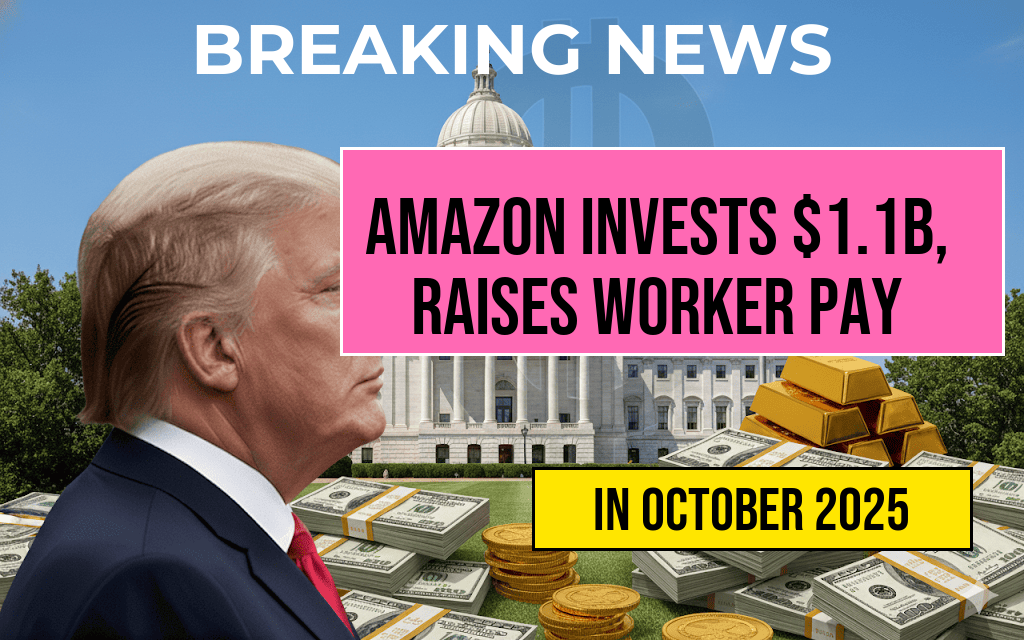Amazon announced a significant investment of $1.1 billion aimed at enhancing its fulfillment operations, a move that has concurrently elevated the average pay for its warehouse and logistics workers to over $23 per hour. This strategic infusion underscores Amazon’s ongoing commitment to improving worker compensation amidst evolving industry standards and ongoing labor market pressures. The funding, allocated over the upcoming fiscal year, is expected to bolster warehouse infrastructure, implement advanced automation, and most notably, provide substantial pay raises to thousands of fulfillment employees across the United States.
Details of the Investment and Pay Increase
Amazon’s latest capital injection is part of its broader initiative to optimize fulfillment centers and solidify its position as a leader in online retail logistics. According to the company, the $1.1 billion will be distributed toward expanding warehouse capacity, upgrading technology, and increasing workforce wages. The company states that the average hourly wage for fulfillment workers has now surpassed $23, marking a notable rise from previous figures that hovered around $18 to $20 per hour.
Amazon’s spokesperson highlighted that this wage increase reflects their recognition of the vital role that fulfillment employees play in delivering customer satisfaction. The move aligns with the company’s strategy to attract and retain skilled workers amid a tight labor market, where competition from other logistics firms and retailers intensifies.
Impacts on Workforce and Industry Standards
The wage hike is expected to benefit more than 150,000 workers across Amazon’s network of fulfillment centers and delivery stations. Employees will see their hourly pay increase by an average of 10% to 15%, with some locations experiencing even higher boosts depending on regional cost of living and operational needs.
| Region | Average Hourly Pay (Before) | Average Hourly Pay (After) |
|---|---|---|
| National Average | $20 | $23+ |
| California | $21 | $24.50 |
| Texas | $19.50 | $22.50 |
Experts say the adjustment could influence wages across the logistics sector. “Amazon’s move sends a clear signal to competitors and suppliers that paying competitive wages is essential to maintaining operational efficiency,” notes labor economist Dr. Lisa Carter. Learn more about logistics industry trends on Wikipedia.
Strategic Rationale Behind the Investment
Amazon’s substantial investment arrives amid heightened scrutiny over working conditions and compensation. While the company has historically faced criticism regarding warehouse labor practices, recent initiatives suggest a push toward more sustainable employment models. The infusion of capital aims to address fulfillment capacity constraints, especially during peak shopping periods, and to integrate advanced automation tools to improve productivity.
Moreover, this investment aligns with Amazon’s broader ambitions to reduce delivery times and enhance customer experience. By increasing wages, Amazon aims to reduce turnover and foster a more stable workforce, which is critical as the company continues to expand its logistics network globally. Industry analysts point out that higher wages may also serve as a buffer against rising inflation and labor shortages.
Reactions from Stakeholders
Employees and labor advocates have largely welcomed the increase. Sarah Johnson, a fulfillment center worker in Ohio, shared, “This raise makes a real difference for my family. It shows Amazon is valuing our work.” Conversely, some critics argue that while wage increases are positive, they do not fully address broader concerns about working conditions and hours.
Labor unions and advocacy groups remain cautious, emphasizing the need for comprehensive reforms beyond wages. “Pay is part of the equation, but employee safety, fair scheduling, and job security are equally important,” stated a representative from the Retail, Wholesale and Department Store Union.
Broader Economic and Industry Context
Amazon’s wage increases follow a series of comparable moves across the retail and logistics sectors, where companies are raising pay to meet staffing demands. According to the Forbes, wages in the warehouse industry have surged in recent months as firms compete for a shrinking pool of qualified workers.
This trend reflects a broader shift in the labor market, where companies recognize that competitive pay is critical to attracting talent in a tight employment landscape. Experts predict that such investments may become more commonplace as firms seek to balance automation with human labor and maintain operational resilience.
Looking Ahead
As Amazon continues its strategic push to reinforce its logistics infrastructure, the recent wage hikes and capital investment set a precedent for industry standards. The company’s approach aims to sustain its growth trajectory while addressing the evolving expectations of its workforce and stakeholders. Observers will be watching closely to see how these investments influence overall employee satisfaction, operational efficiency, and industry wage norms in the coming months.
Frequently Asked Questions
What is the total amount Amazon has invested in its fulfillment workers’ pay?
Amazon has invested $1.1 billion to increase the pay for its fulfillment workers.
How has Amazon’s investment impacted the average pay of its fulfillment workers?
Following the investment, the average pay for Amazon’s fulfillment workers has risen to over $23 per hour.
Which areas or roles do these pay increases affect?
The pay increase primarily benefits fulfillment center employees involved in processing and shipping customer orders across various locations.
When did Amazon implement the new pay rates for fulfillment workers?
Amazon announced the pay boost and the $1.1 billion investment as part of its recent efforts to enhance employee compensation, effective from October 2023.
What are the broader implications of Amazon’s investment for the retail and logistics industry?
This $1.1 billion investment demonstrates Amazon’s commitment to competitive wages and may influence other companies in the retail and logistics sectors to improve their employee compensation strategies.




